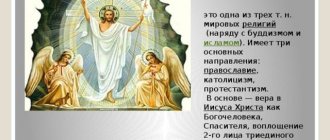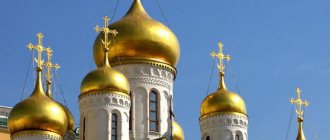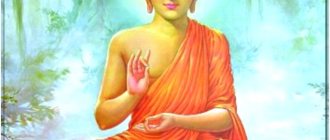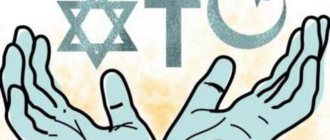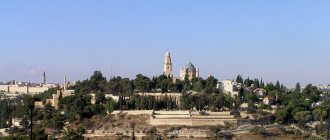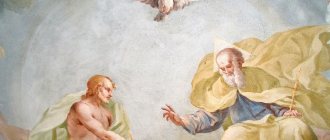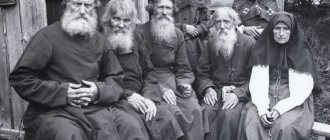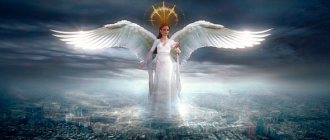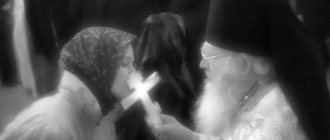The issue of religion is discussed and studied in every state and society. In some places it is especially acute and is quite conflicting and dangerous, in others it is more like small talk in free time, and in others it is an occasion to philosophize. In our multinational society, religion is one of the most pressing issues. Not every believer is well aware of the history of Orthodoxy and its origins, but when asked about Orthodoxy, we will all answer unequivocally that Orthodoxy is the Christian faith.
What is Orthodoxy
Orthodoxy is one of the three main trends in Christianity (along with Catholicism and Protestantism), which developed in the first millennium after Christ on the territory of the Eastern Roman Empire (Byzantium). It ranks third in number (about 300 million people) among Christian movements after Catholicism (1.25 billion) and Protestantism (800 million).
The very word “Orthodoxy” (calque from Greek ὀρθοδοξία) literally means “correct glorification” or “correct opinion.” The word is translated from Greek as “orthodoxy.” In the Russian translation there is an association with the word “right” or “correctly”. Although in Greek "orthos" means "straight" or "right". That is, the direct path to the Lord: you do not turn either to the right or to the left. And the word “doxia” means “opinion” or “thought.” Therefore, Orthodoxy is correct thoughts about God. This is the translation.
Orthodox countries of the world
The religion Orthodoxy is professed by approximately 220 to 250 million people. This number of believers is a tenth of all Christians on the planet. Orthodoxy is spread throughout the world, but the highest percentages of people who profess this religion are in Greece, Moldova and Romania - 99.9%, 99.6% and 90.1% respectively. Other Orthodox countries have a slightly lower percentage of Christians, but Serbia, Bulgaria, Georgia and Montenegro also have high percentages.
The largest number of people whose religion is Orthodoxy live in the countries of Eastern Europe and the Middle East; there are a large number of religious diasporas throughout the world.
When Orthodoxy appeared: a brief history
The term originated in the 4th century. In general, the Orthodox Church comes from the apostles. It's just that in ancient times there was a different word. What we call Orthodoxy was called piety in the days of the first Christians. In the ancient sense, piety is the proper reverence of God. It’s just that the definition of the Orthodox Church has changed. This is all one reality, which does not include false teachings. And since the first century there have been divisions within Christianity. The Church does not know a single period when everyone was united.
In Russian history, starting from the baptism of Rus' in the 10th century, the church was associated with state power. And church leaders (initially metropolitans, and from 1589 patriarchs) were always part of the tsar’s inner circle. Orthodoxy was the dominant denomination.
For more than four centuries, Russians lived under the unspoken rule of the Byzantine Church. However, the Moscow church claimed its own exclusivity, and in 1448 the Moscow priests declared their own independence, not recognized by Constantinople and the rest of the world in general. And after another 140 years, the new church had an official head - the patriarch.
With the fall of the monarchy, a period of testing began for the Russian Church. With the beginning of the revolution in Russia, a policy of forcibly imposing atheism unfolded. The result was the looting of many temples.
State pressure on the church weakened in the last months of 1941, after a series of military failures by Soviet troops in the war with Germany. The war of 1941–1945 united believers and non-believers.
After the collapse of the USSR in 1991, the Russian Orthodox Church began to revive, and at the same time, the persecution of believers, widespread in Soviet times, ceased. The revival of the old ones began (about 1.5 thousand survived out of the 50 thousand that existed before the 1917 revolution) and the construction of new Christian churches.
The emergence and development of Orthodoxy
Many scriptures and teachings, both ancient and modern, report that the Orthodox faith is true Christianity, citing their arguments and historical facts. And the question – “Orthodoxy or Christianity” – will always worry believers. But we will talk about accepted concepts.
Christianity is the largest form of social consciousness in the world, preaching the life path and teachings of Jesus Christ. According to historical data, Christianity arose in Palestine (part of the Roman Empire) in the 1st century.
Christianity was widespread among the Jewish population, and subsequently gained more and more recognition among other peoples, the so-called “pagans” at that time. Thanks to educational and propaganda activities, Christianity spread beyond the Roman Empire and Europe.
One of the ways of development of Christianity is Orthodoxy, which arose as a result of the division of churches in the 11th century. Then, in 1054, Christianity was divided into Catholicism and the Eastern Church, and the Eastern Church was also divided into several churches. The largest of them is Orthodoxy.
The spread of Orthodoxy in Rus' was influenced by its proximity to the Byzantine Empire. From these lands, the history of the Orthodox religion begins. Church power in Byzantium was divided due to the fact that it belonged to four patriarchs. The Byzantine Empire disintegrated over time, and the patriarchs uniformly headed the created autocephalous Orthodox churches. Subsequently, autonomous and autocephalous churches spread to the territories of other states.
The fundamental event in the formation of Orthodoxy in the lands of Kievan Rus was the baptism of Princess Olga in 954. This later led to the baptism of Rus' - 988. Prince Vladimir Svyatoslavovich called all the inhabitants of the city, and a baptism ceremony was performed in the Dnieper River, which was performed by Byzantine priests. This was the beginning of the history of the emergence and development of Orthodoxy in Kievan Rus.
The active development of Orthodoxy in Russian lands has been observed since the 10th century: churches, temples are being built, and monasteries are being created.
What Orthodox Christians Believe: Basic Provisions of Christianity
There are four main points in dogmatics. The first is belief in the Trinity: Father, Son and Holy Spirit. For us these are not three gods. These are not three masks of the same deity. These are three divine personalities between whom there is relationship and communication. And this relationship is love. This is where the main Christian commandment comes from - love. After all, we are created in the image and likeness of God.
Second, Christ is God and man. Why is it important? God is invulnerable. And here he took on human flesh and soul to make himself vulnerable. To experience human suffering: both physical and mental. This brings God closer to us. And the practical application is that when we turn to the Lord in prayer, he understands us, because he felt it all here on earth.
Third is belief in the resurrection. Christ, after being crucified on the cross, descended into hell and conquered death. He was resurrected in the flesh. And we believe that we will be resurrected in the flesh like Christ after his second coming. We believe that we will enter eternal life with both soul and body. Therefore, physical exploits are also important in spiritual life. For example, marital fidelity. Our body is a temple of the Holy Spirit. It belongs to Christ and the wife. No one else.
Fourth is faith in the church. Christians believe that it is impossible to come to God without church. It's not about the building. You need to get closer to other people. The fact that we gather together for prayer in church is the most important moment. You cannot approach God by moving away from other people.
List of Orthodox countries
An Orthodox country is one in which Orthodoxy is recognized as the state religion.
The country with the largest number of Orthodox Christians is the Russian Federation. In percentage terms, it is, of course, inferior to Greece, Moldova and Romania, but the number of believers significantly exceeds these Orthodox countries.
- Greece – 99.9%.
- Moldova – 99.9%.
- Romania – 90.1%.
- Serbia – 87.6%.
- Bulgaria – 85.7%.
- Georgia – 78.1%.
- Montenegro – 75.6%.
- Belarus - 74.6%.
- Russia - 72.5%.
- Macedonia - 64.7%.
- Cyprus - 69.3%.
- Ukraine - 58.5%.
- Ethiopia - 51%.
- Albania - 45.2%.
- Estonia - 24.3%.
The distribution of Orthodoxy across countries, depending on the number of believers, is as follows: in first place is Russia with the number of believers 101,450,000 people, Ethiopia has 36,060,000 Orthodox believers, Ukraine - 34,850,000, Romania - 18,750,000, Greece - 10,030,000, Serbia - 6,730,000, Bulgaria - 6,220,000, Belarus - 5,900,000, Egypt - 3,860,000, and Georgia - 3,820,000 Orthodox.
Differences between Orthodoxy and Catholicism
The final division of the United Christian Church into Orthodoxy and Catholicism occurred in 1054. However, both the Orthodox and Roman Catholic churches consider themselves only “one holy, catholic (conciliar) and apostolic Church.”
The main differences between Orthodoxy and Catholicism can be reduced to several points:
- So, the first difference between the Catholic and Orthodox Churches is the different understanding of the unity of the Church. For the Orthodox it is enough to share one faith and sacraments; Catholics, in addition to this, see the need for a single head of the Church - the Pope;
- The Catholic Church confesses in the Creed that the Holy Spirit proceeds from the Father and the Son (“filioque”). The Orthodox Church confesses the Holy Spirit emanating only from the Father. Some Orthodox saints spoke about the procession of the Spirit from the Father through the Son, which does not contradict Catholic dogma.
- The Catholic Church professes that the sacrament of marriage is for life and prohibits divorce, while the Orthodox Church allows divorce in some cases.
- The Catholic Church proclaimed the dogma of purgatory. This is the state of souls after death, destined for heaven, but not yet ready for it. There is no purgatory in Orthodox teaching (although there is something similar - ordeal). But the prayers of the Orthodox for the dead suggest that there are souls in an intermediate state for whom there is still hope of going to heaven after the Last Judgment;
- The Catholic Church accepted the dogma of the Immaculate Conception of the Virgin Mary. This means that even original sin did not touch the Mother of the Savior. Orthodox Christians glorify the holiness of the Mother of God, but believe that she was born with original sin, like all people;
- The Catholic dogma of Mary's assumption to heaven body and soul is a logical continuation of the previous dogma. The Orthodox also believe that Mary resides in Heaven in body and soul, but this is not dogmatically enshrined in Orthodox teaching.
- The Catholic Church has accepted the dogma of the primacy of the Pope over the entire Church in matters of faith and morals, discipline and government. The Orthodox do not recognize the primacy of the Pope.
- The Catholic Church has proclaimed the dogma that the Pope is infallible in matters of faith and morals when he, in agreement with all the bishops, affirms what the Catholic Church has already believed for many centuries. Orthodox believers believe that only the decisions of the Ecumenical Councils are infallible.
- Orthodox Christians cross from right to left, and Catholics cross from left to right. Catholics were long allowed to be baptized in either of these two ways until Pope Pius V ordered them to do so from left to right and no other way in 1570. With such a movement of the hand, the sign of the cross, according to Christian symbolism, is considered to come from a person who turns to God.
Coexistence of Orthodoxy with other religions
Speaking about the relationship of Orthodoxy to other religions, it is worth emphasizing such traditional religions as Judaism, Islam and Buddhism.
- Judaism. The religion is exclusively of the Jewish people. It is impossible to belong to Judaism without Jewish origin. For a long time, the attitude of Christians towards Jews has been quite hostile. Differences in understanding the person of Christ and his story greatly divide these religions. Repeatedly, such hostility led to cruelty (Holocaust, Jewish pogroms, etc.). On this basis, a new page began in relations between religions. The tragic fate of the Jewish people forced us to reconsider our relationship with Judaism, both at the religious and political levels. However, the general basis is that God is one, God the Creator, a participant in the life of every person, which today helps such religions as Judaism and Orthodoxy to live in harmony.
- Islam. Orthodoxy and Islam also have a difficult history of relationship. Prophet Muhammad was the founder of the state, military leader, and political leader. Therefore, religion is very closely intertwined with politics and power. Orthodoxy is a free choice of religion, regardless of nationality, territoriality and language a person speaks. It should be noted that in the Koran there are references to Christians, Jesus Christ, the Virgin Mary, these references are respectful and respectful. There are no calls for negativity or blame. At the political level, there are no conflicts of religions, but this does not exclude confrontations and hostility in small social groups.
- Buddhism. Many clergy reject Buddhism as a religion because it has no understanding of God. Buddhism and Orthodoxy have similar features: the presence of temples, monasteries, prayers. It is worth noting that the prayer of an Orthodox person is a kind of dialogue with God, who appears to us as a living Being from whom we expect help. A Buddhist's prayer is more of a meditation, a reflection, an immersion in one's own thoughts. This is a fairly good religion that cultivates kindness, calmness, and will in people. In the entire history of the coexistence of Buddhism and Orthodoxy, there have been no conflicts, and it is impossible to say that there is potential for this.
Basic sacraments of Orthodoxy
The first is the sacrament of Baptism, in which we are united with Christ. Because immersion in water is a symbol of death, just as the Savior died and was buried. When a person is raised from the water, it is a symbol of resurrection. And the threefold immersion is performed in the name of the Holy Trinity.
The second is the sacrament of confirmation. In it, a person is given the gift of the holy spirit. It takes place after baptism. And the goal of a person’s life is to develop this gift in oneself.
Third – Communion or Eucharist. Through it, the connection formed between a person and Christ during Baptism is maintained throughout life.
Fourth - confession. It helps a person get rid of sins for further work on himself.
Fifth - wedding. It makes husband and wife one.
Basics of Christianity
This religion is based on dogmas, which are interpreted in the Holy Scriptures and in Holy Tradition.
The first includes the book of the Bible, consisting of two parts (New and Old Testaments), and the Apocrypha, which are sacred texts that were not included in the Bible.
The second consists of seven ecumenical councils and the works of the church fathers who lived in the second to fourth centuries AD. These people include John Chrysostom, Athanasius of Alexandrovsky, Gregory the Theologian, Basil the Great, and John of Damascus.
Major Orthodox holidays
Almost everyone knows that the main Orthodox (and Christian in general) holiday is Easter. However, along with it, there are several other significant dates.
Easter
The Feast of Feasts, or “great day,” is Easter, commemorating the resurrection of Jesus Christ from the dead. The oldest of all Christian holidays was celebrated by the apostles, and it was they who bequeathed to celebrate Christian Easter on the first Sunday after the vernal equinox, a week after the Jewish Passover. The dates for celebrating Easter and other moving holidays for each year are contained in the so-called. Easter.
The Easter service differs from all holiday services in its festivity and solemnity. Before the start of Easter Matins, the clergy put on light sacred vestments. Exactly at midnight, the procession of the cross begins: the church goes “to the meeting” of Christ who rose from the tomb.
In front of the closed doors of the temple, hymns to the Holy Trinity are pronounced, after which, with the singing of the Easter troparion (“Christ is risen from the dead, trampling down death by death and giving life to those in the tombs!”), the believers enter the church. At the end of Matins, everyone present in the church greets each other with the exclamation “Christ is Risen!” and give Easter red eggs, a symbol of resurrection and life.
Nativity
December 25 (January 7) is a great day for the entire Christian world. Its forefeast begins five days before the holiday itself. The eve of the holiday is called Christmas Eve. On Christmas Eve they read the so-called Royal clock, this service is performed with the royal doors open in the center of the temple in front of the Gospel, placed on a lectern as a sign that from now on the Savior is among the people.
The Christmas night service begins with the singing of the solemn song God is with us... and the pronouncement of Isaiah's prophecy about the Savior. By celebrating the Nativity of Christ, the Church glorifies in the born Baby the true union of divine nature with human nature and the coming into the world of the Sun of Truth. The holiday is preceded by a 40-day Nativity (or “Philippov”) fast. The twelve days after the holiday are called Christmastide, or holy days.
Nativity of the Virgin Mary
September 8 (21). The liturgical year begins in September. The first twelfth holiday of autumn is the Nativity of the Virgin Mary. It is set in the 4th century. and o - the birth of the Mother of God. The circumstances of the birth of the Virgin Mary are described in detail in the apocryphal Gospel of James. It tells the story of a pious but childless Jewish couple, Joachim and Anna, who were destined to become the parents of the Virgin Mary.
Mary was born into a family of righteous people; among her ancestors there were many famous men of the Old Testament. The appearance into the world of the Virgin Mary, the “pure vessel of God,” was prepared by the feat of piety of many generations. On the eve of the Feast of the Nativity of the Virgin Mary, an all-night vigil is celebrated with the reading of proverbs and litia. The proverbs include biblical texts describing events and phenomena that typify the Mother of God. Celebrating the Nativity of the Virgin Mary,
The Church glorifies the highest degree of approach of the Divine to humanity. According to the words of John of Damascus, the day of the Nativity of Mary is a holiday of universal joy, because “through the Mother of God the entire human race was renewed and the sorrow of the foremother Eve was changed into joy.”
Transfiguration
August 6 (19). This holiday is a remembrance of how Jesus appeared to the disciples in the glory of his Divinity, transfigured before them on Mount Tabor. According to the Synoptic Gospels, this event was witnessed by three people - the beloved disciples of Jesus - the apostles Peter, John and James.
Transfiguration symbolizes the appearance of the new Heavenly Kingdom and announces the future transformation of creation (the created world). The Christian holiday of the Transfiguration coincides with the period of harvesting fruits, so on this day it is customary to bring the fruits of the new harvest to church for blessing (hence the popular name of the holiday “Apple Savior”).
Dormition of the Mother of God
August 15 (28). This is the last twelfth holiday of the church year. The Dormition of the Mother of God is death, the end of Mary’s earthly life. But the death of the Mother of God is surrounded not by sadness, but by joy. Beyond the threshold of death, her resurrection and ascension to Heaven awaited her. At the bed of the Mother of God, the union of the earthly and heavenly churches took place, since the living and already dead apostles, Jerusalem priests and virgins, angels and archangels appeared to say goodbye to Mary.
The holiday is preceded by a two-week Assumption Fast. The service begins with an all-night vigil with paremias, at which the Holy Shroud of the Mother of God is carried out to the middle of the temple. The next day, the rite of burial of the Mother of God is performed, during which the shroud is carried around the temple three times.
Entry of the Lord into Jerusalem
The royal entry of Jesus Christ into Jerusalem is celebrated on Sunday a week before Easter. The liturgy remembers how the Savior came with his disciples to Jerusalem for the holiday of Easter and entered the city as a sign of humility, “sitting on a young donkey.” The people, having heard about the miracles he performed, greeted him as a king, spreading clothes and palm branches before him.
According to tradition, believers come to the temple on this day with branches of blossoming willow, which have replaced palm branches in Russia. The branches brought as a gift to Christ are consecrated during the service by sprinkling with holy water. Like palm branches, they serve as a symbol of victory over death and firm faith in the resurrection.
Ascension
The Ascension is celebrated on the fortieth day after Easter. After his resurrection, Christ appeared to the disciples, assuring them of the truth of the resurrection, and preparing them to preach the Gospel to all nations. On the last day of his stay on earth, He ascended the Mount of Olives, blessed the apostles, raised his hands to Heaven, and the shining cloud of Glory hid him.
The Ascension of the Lord is a Christological dogma: the glorified human nature of Christ after the Ascension entered into the intradivine life of the Holy Trinity. Therefore, the church in the chants of the holiday calls to glorify the ascended Life-Giver Christ.
Pentecost
Pentecost, or Trinity Day, is celebrated on the fiftieth day after Easter. It was on the fiftieth day after his rise from the grave that the Lord sent the Holy Spirit to the disciples to invest them with power from above. The Holy Spirit descended on the apostles in the form of tongues of flame, symbolizing the living and active word, with the help of which they were called to preach the Gospel to the nations. The Day of Pentecost is considered the beginning of the history of the church, the day of its birth.
The Feast of Pentecost lasts a whole week. The first day is entirely devoted to the glorification of the Holy Trinity. On the second day the Holy Spirit is glorified. Trinity Vespers includes special kneeling prayers in the name of the Most Holy Trinity, divided into three parts. These prayers are said by the rector of the temple, kneeling in the royal doors. In them he asks the triune God to sanctify all the dead and living on earth. In Russian tradition, the day of the Holy Trinity was associated with seeing off spring and welcoming summer.
Autocephaly what is in the church in simple language
The Holy Spirit also comes from the Son of God, to the same extent as from the Father; he was born of an immaculate virgin and was accepted into heaven in body and not only in soul; * Catholics venerate a large number of different Saints; * the pope, as the Supreme Hierarch of the church, considers all actions infallible; * after the death of the body, the soul is not killed, unlike Orthodox Christianity, but it turns out that they are in purgatory, where trials await them; For communion you need bread without yeast.
The fundamental difference between Catholic Christianity and Orthodoxy is the concept of atonement for sins with gifts (indulgences). Western tradition believes that Christ, the Mother of God and the saints through their actions created an inexhaustible supply of kindness, which is enough to cover all the sins of the entire Christian community. The Sanctuary of Goodness is owned by the Christian Catholic Church and is sold to sinners in the form of special ratifications, meaning homeowners receive absolution.
